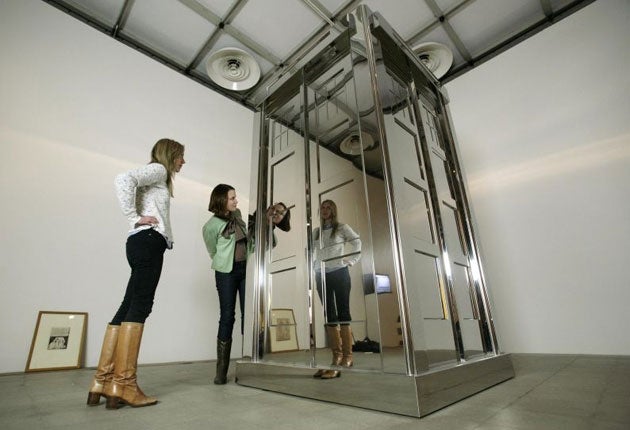The Russian Linesman, Hayward Gallery, London
Turner Prize-winner Mark Wallinger finds connections between his and other artists’ work in a highly diverse show

The blood-brain barrier exists to stop the grey matter from being invaded by unpleasant organisms, which means that Mark Wallinger’s head should, theoretically, be safe from critics. Wallinger laughs at barriers, though, so you’re welcome to stroll around his mind, this being the subject of the Hayward Gallery’s show The Russian Linesman. And since Wallinger’s brain is both large and elegantly appointed, the walk is long and lovely.
You’ll probably remember State Britain (2007), the protest wall Wallinger copied from one in Parliament Square and had rebuilt in the Tate’s Duveen Galleries. At the time, I’m ashamed to say, I saw the work as a piece of agitprop. It was that, too, but State Britain’s real interest was in the human preoccupation with boundaries. An ill-considered piece of Blairite legislation outlawed demonstrations within a kilometre of Parliament: Wallinger’s peace camp sat exactly astride that limit, daring someone to do something about it. State Britain got away with it by crossing other boundaries as well: the piece may have been political, but it was also an artwork. Governments merely have to be stupid to ban protests. They would have to be suicidal to ban art.
As with State Britain, so with The Russian Linesman. True to Wallinger’s modest form, few of the objects in the show are his own – apart from some stereoscopic photographs, only the mirrored Tardis, Time and Relative Dimensions in Space. Part of the Turner Prize-winner’s aim is to blur the boundaries between his own work and other people’s, between making and curating, art and non-art. To do this, Wallinger turns himself into an aesthetic Doctor Who, lighting here on a Dürer woodcut, made in Nuremberg in 1498, there on a piece of YouTube footage of the Indo-Pakistani border, made God knows where or when. There is no beginning or end to The Russian Linesman, and no indication of how you should go around it. As with the beliefs that underlie the show, there are no boundaries, no rules of engagement other than a willingness to make connections.
So here’s what you might do. Start with something that catches your eye – TV footage of Philippe Petit’s 1974 tightrope walk between the towers of the World Trade Center, say. Next to this is Dürer’s woodcut of an artist using a perspective machine. Five centuries of art history have taught us to see these images as irreconcilably different. Viewed through the optic of Wallinger’s playful eye, though, they seem surprisingly alike, the thin thread of Petit’s tightrope describing the yawing height of the twin towers just as Dürer’s dotted line spells out perspective.
From here you pass on to Amie Siegel’s video Berlin Remake. This is literally what it says it is – an earlier film re-made and projected alongside the original – although the title also suggests the remaking of Berlin. Siegel’s film shares German-ness with Dürer and with the next work along the wall, Thomas Demand’s Poll. But Poll is also political, and also a recreation – this time, the cardboard model of a Florida voting station from George W Bush’s contested first election. And Demand’s recycling, like Siegel’s, works on two levels. His counters and telephones are made of paper, but so are his electoral papers.
Where next? The choice is yours. Fred Sandback’s Constructions outline space with lengths of yarn, solidifying what isn’t there à la Demand. But also à la Elaine Sturtevant, whose Duchamp, 11 rue Larrey, next up, is an open door to a corridor. Which is like William Blake’s Death’s Door, which is like Dürer’s Saint John Devouring the Book, in being over-literal: Blake’s door is a door; Dürer’s visionary eats his words like a sandwich. Beyond these again is a lift door which (very funny, Mark) turns out to be a lift door. And beyond that … well.
There is no beyond that, or not in any usual sense of the word. As far as you can get, Hayward-wise, from Sturtevant’s corridor is another, oddly like it. This one is by Monika Sosnowska and is called, blankly, Corridor. Had Sosnowska seen Sturtevant’s work, made a dozen years before? Who knows? Who cares? The connections Wallinger hints at are about leaps of imagination rather than the marching steps of history – about the untidiness of time and space, their unwillingness to be ordered.
As you walk through The Russian Linesman, boundary after boundary falls before you: between now and then, here and there, two dimensions and three, surface and depth, art and life. The infinite riches in Wallinger’s little room are reflected back at you from the polished steel walls of his Tardis, so that every thing in the show has its equal and opposite anti-thing. You could stay a long time in the Time Lord’s head, potentially for ever. I can think of worse fates.
Hayward Gallery, London SE1 to 4 May (0871 663 2501)
Join our commenting forum
Join thought-provoking conversations, follow other Independent readers and see their replies
Comments